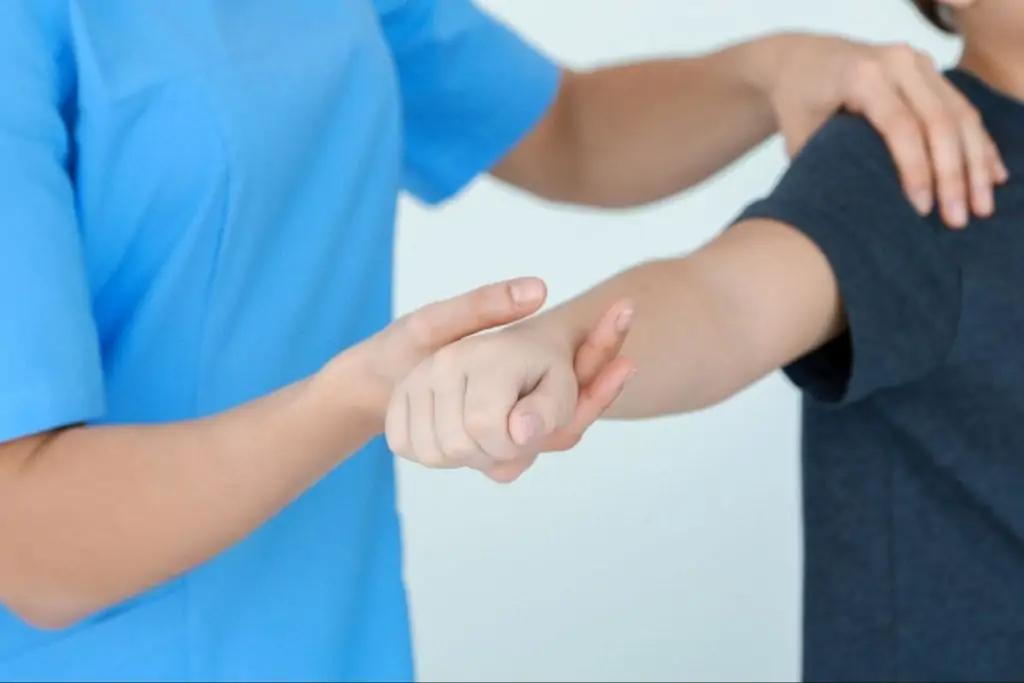
Pediatric Chiropractic Care: 3 Common Questions Every Parent Has
- posted: Nov. 03, 2021
Most of the time, chiropractic care is associated with adults. After all, people seek these specialists to ease headaches, pain, or other aches that are part of adult life. So why would a child need chiropractic treatment? What is pediatric chiropractic treatment? Should you take your child to a chiropractor? Find the answer to these and other common questions about pediatric chiropractic care below.

The Basics: What Is Pediatric Chiropractic Treatment?
Pediatric chiropractic care is similar to adult chiropractic care in that all of it focuses on the health and wellness of the spine. “If you have a spine, it’s good to get it checked out. You might not need it adjusted, but you know, having it checked out, making sure that it’s moving properly is a good thing,” explains Dr. Kyle Smerglia of Smerglia Chiropractic. Adjusting a pediatric patient typically amounts to very slight, gentle pressure. “I’m going to adjust an adult completely differently than I am a kid,” continues Dr. Smerglia. “They’re all cartilage. They’re not ossified bones like adults are.”
1. Should I take my child to the chiropractor?
Absolutely. In fact, we recommend that you schedule your first appointment as soon as possible. “I don’t think people realize that we can see patients from birth,” says Dr. Smerglia.
“The birthing process is pretty traumatic, whether it’s C-section or vaginal. I mean there’s tugging and pulling and you’re altering the shape of the baby to try and get the baby out into the world. Think about the trauma that can do to the neck or the back.” Additionally, infancy can be slightly traumatic. This is when children learn to crawl, stand, walk, hop, tumble, and run. What’s more, kids are always in a state of discovery and play, engaging themselves in numerous indoor and outdoor games.
All these pursuits may lead to shifts in their musculoskeletal system, which lead to subluxations. The spinal nerves may develop misalignments that affect the efficient functioning of their nervous system. What’s more, the body’s ability to function optimally will be altered, setting the stage for headaches, asthma, ear infections, etc.
Pediatric chiropractic therapy comes through to correct misalignments via spinal adjustment. In turn, this improves the kid’s well-being and protects them from health concerns in the future.
The key is to ensure you are seeking the services of an experienced, practiced clinician who is actively working with a pediatric patient. Pediatric chiropractic care is safe when executed properly. “There should be very little that can go wrong because the chiropractor uses such little force. We’re not popping anything. You’re not hearing any cavitations. It is not at all like when adjusting adults,” according to Dr. Smerglia. Further, pediatric chiropractic therapy is natural and medication-free.
2. Why should kids get adjusted?
Children and adults display varying physiological differences. They experience and express ailments differently. When an adult is experiencing discomfort, upset, pain, or simply notices a change in the way they feel, they can tell you about it. Children, especially infants and toddlers, can’t. This often leaves parents asking, “How do I know my baby/child should be adjusted?” Dr. Smerglia is very familiar with this predicament. “Mom and dad notice a change. They voice that concern. That’s how we know to look for something in an infant. For example, one of our patients brought her son in, when he was about two weeks old. He was colicky, fussy, didn’t get much sleep. Mom was at her wit’s end. She didn’t know what to do. She’d done everything, met all his needs and he just kept crying. So, she brought him in to see me.
When I adjust infants, they’re on mom’s chest. So, he was laying belly to belly with mommy and I could feel the top segment of his neck was shifted (likely as a result of childbirth). Ultimately, his segment had shifted a little bit during birth and you could feel it. As soon as I put pressure on it and felt that release, he went from flailing and crying and being crazy to literally falling asleep on mom. We didn’t hear a peep out of him the rest of the time they were in the office.
About two weeks later she came back for her adjustment and said that it was a night and day difference, like being with a completely different child now.”
3. How can my child benefit from adjustment?
Still not sure pediatric chiropractic care is for your child? From improved immune systems to better sleep and concentration, here’s a list of other benefits of pediatric chiropractic treatment:
- Improved immune system – Sick seasons can be challenging for kids and their parents alike. But pediatric chiropractic care can support the child’s immune system, allowing them to effectively fight the illness. The treatment can reduce sickness duration and prevent the ailment from flaring up.
- Better sleep – A child requires quality sleep for optimal functionality during the day and emotional and physical growth. However, spinal misalignments may prevent them from enjoying their good night’s sleep. Gentle adjustments can be performed to treat the misalignments and improve the child’s sleep.
- Behavior improvement – Stress affects children emotionally and physically. Kids can undergo stressful situations that may lead them to act out as the only way of coping. Chiropractic adjustments help alleviate stress, hence improving the child’s mood and overall behavior.
- Improved brain development – Spinal misalignments in children can exacerbate disorders like ADHD or ADD. Pediatric chiropractic treatment can help them concentrate and stay focused. The adjustments can help relieve pressure on their bones, joints, and spine, hence improving neural brain development.
- Eases the early stages of development – Infants come with their unique concerns. For example, most children struggle with colic during the initial months, leading them to cry continuously. Chiropractic care can correct spine misalignment, colic, and trouble latching.

The Bottom Line
Chiropractic care is for the whole family. From birth to old age (and everything in between) chiropractic care can help improve quality of life and Getting your spine checked from birth up is definitely beneficial. It keeps the body functioning at its best. Don’t shy away from pediatric chiropractic care; starting to care at infancy aids in ensuring your child’s health is set upon and continues on the right path.
If you are looking for a reliable pediatric chiropractor to improve your child’s health, then you’re in the right hands. Smerglia Chiropractic is where you’ll begin your child’s journey to wellness. We support spinal age for patients of different ages and focus on creating healthy families in Cuyahoga Falls, Oh, and beyond. Contact us or schedule an appointment with us today so we can begin your journey to wellness.

Pediatric Chiropractic Care: 3 Common Questions Every Parent Has
- posted: Nov. 03, 2021
Most of the time, chiropractic care is associated with adults. After all, people seek these specialists to ease headaches, pain, or other aches that are part of adult life. So why would a child need chiropractic treatment? What is pediatric chiropractic treatment? Should you take your child to a chiropractor? Find the answer to these and other common questions about pediatric chiropractic care below.

The Basics: What Is Pediatric Chiropractic Treatment?
Pediatric chiropractic care is similar to adult chiropractic care in that all of it focuses on the health and wellness of the spine. “If you have a spine, it’s good to get it checked out. You might not need it adjusted, but you know, having it checked out, making sure that it’s moving properly is a good thing,” explains Dr. Kyle Smerglia of Smerglia Chiropractic. Adjusting a pediatric patient typically amounts to very slight, gentle pressure. “I’m going to adjust an adult completely differently than I am a kid,” continues Dr. Smerglia. “They’re all cartilage. They’re not ossified bones like adults are.”
1. Should I take my child to the chiropractor?
Absolutely. In fact, we recommend that you schedule your first appointment as soon as possible. “I don’t think people realize that we can see patients from birth,” says Dr. Smerglia.
“The birthing process is pretty traumatic, whether it’s C-section or vaginal. I mean there’s tugging and pulling and you’re altering the shape of the baby to try and get the baby out into the world. Think about the trauma that can do to the neck or the back.” Additionally, infancy can be slightly traumatic. This is when children learn to crawl, stand, walk, hop, tumble, and run. What’s more, kids are always in a state of discovery and play, engaging themselves in numerous indoor and outdoor games.
All these pursuits may lead to shifts in their musculoskeletal system, which lead to subluxations. The spinal nerves may develop misalignments that affect the efficient functioning of their nervous system. What’s more, the body’s ability to function optimally will be altered, setting the stage for headaches, asthma, ear infections, etc.
Pediatric chiropractic therapy comes through to correct misalignments via spinal adjustment. In turn, this improves the kid’s well-being and protects them from health concerns in the future.
The key is to ensure you are seeking the services of an experienced, practiced clinician who is actively working with a pediatric patient. Pediatric chiropractic care is safe when executed properly. “There should be very little that can go wrong because the chiropractor uses such little force. We’re not popping anything. You’re not hearing any cavitations. It is not at all like when adjusting adults,” according to Dr. Smerglia. Further, pediatric chiropractic therapy is natural and medication-free.
2. Why should kids get adjusted?
Children and adults display varying physiological differences. They experience and express ailments differently. When an adult is experiencing discomfort, upset, pain, or simply notices a change in the way they feel, they can tell you about it. Children, especially infants and toddlers, can’t. This often leaves parents asking, “How do I know my baby/child should be adjusted?” Dr. Smerglia is very familiar with this predicament. “Mom and dad notice a change. They voice that concern. That’s how we know to look for something in an infant. For example, one of our patients brought her son in, when he was about two weeks old. He was colicky, fussy, didn’t get much sleep. Mom was at her wit’s end. She didn’t know what to do. She’d done everything, met all his needs and he just kept crying. So, she brought him in to see me.
When I adjust infants, they’re on mom’s chest. So, he was laying belly to belly with mommy and I could feel the top segment of his neck was shifted (likely as a result of childbirth). Ultimately, his segment had shifted a little bit during birth and you could feel it. As soon as I put pressure on it and felt that release, he went from flailing and crying and being crazy to literally falling asleep on mom. We didn’t hear a peep out of him the rest of the time they were in the office.
About two weeks later she came back for her adjustment and said that it was a night and day difference, like being with a completely different child now.”
3. How can my child benefit from adjustment?
Still not sure pediatric chiropractic care is for your child? From improved immune systems to better sleep and concentration, here’s a list of other benefits of pediatric chiropractic treatment:
- Improved immune system – Sick seasons can be challenging for kids and their parents alike. But pediatric chiropractic care can support the child’s immune system, allowing them to effectively fight the illness. The treatment can reduce sickness duration and prevent the ailment from flaring up.
- Better sleep – A child requires quality sleep for optimal functionality during the day and emotional and physical growth. However, spinal misalignments may prevent them from enjoying their good night’s sleep. Gentle adjustments can be performed to treat the misalignments and improve the child’s sleep.
- Behavior improvement – Stress affects children emotionally and physically. Kids can undergo stressful situations that may lead them to act out as the only way of coping. Chiropractic adjustments help alleviate stress, hence improving the child’s mood and overall behavior.
- Improved brain development – Spinal misalignments in children can exacerbate disorders like ADHD or ADD. Pediatric chiropractic treatment can help them concentrate and stay focused. The adjustments can help relieve pressure on their bones, joints, and spine, hence improving neural brain development.
- Eases the early stages of development – Infants come with their unique concerns. For example, most children struggle with colic during the initial months, leading them to cry continuously. Chiropractic care can correct spine misalignment, colic, and trouble latching.

The Bottom Line
Chiropractic care is for the whole family. From birth to old age (and everything in between) chiropractic care can help improve quality of life and Getting your spine checked from birth up is definitely beneficial. It keeps the body functioning at its best. Don’t shy away from pediatric chiropractic care; starting to care at infancy aids in ensuring your child’s health is set upon and continues on the right path.
If you are looking for a reliable pediatric chiropractor to improve your child’s health, then you’re in the right hands. Smerglia Chiropractic is where you’ll begin your child’s journey to wellness. We support spinal age for patients of different ages and focus on creating healthy families in Cuyahoga Falls, Oh, and beyond. Contact us or schedule an appointment with us today so we can begin your journey to wellness.
